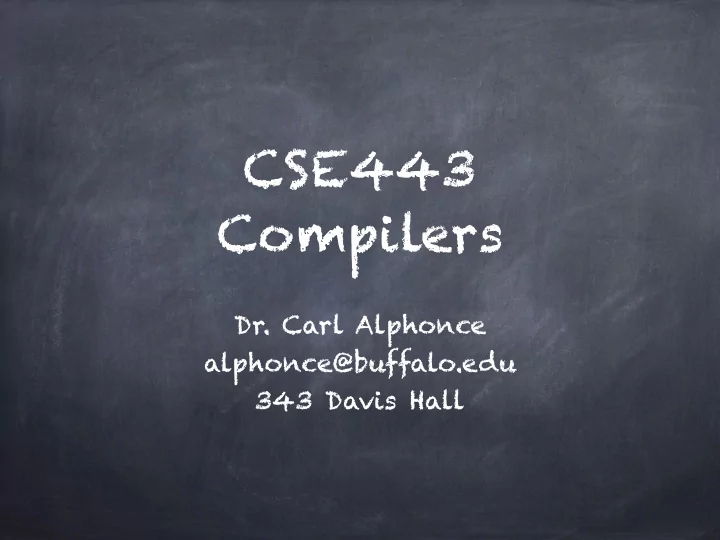

CSE443 Compilers Dr. Carl Alphonce alphonce@buffalo.edu 343 Davis Hall
Syllabus Posted on website Academic Integrity
Textbook Classic text. You should hang on to this one.
Team formation If you have a team, please list members in response to Piazza post. Also indicate your choice: C or SML.
Linotte C French keywords English keywords syracuse : void syracuse() { durée est un nombre int iterations = 0; e est un nombre int e; début e prend 14 e = 14; tant que e != 1 lis while (e != 1) { durée prend durée + 1 iterations = iterations + 1; si (e mod 2) = 0, e prend e / 2 if ( (e % 2) == 0 ) e = e / 2; sinon e prend e * 3 + 1 else e = e * 3 + 1; affiche e printf("%d\n",e); ferme } affiche "durée = {durée}" printf("iterations = %d\n",iterations); } • Keywords have no inherent meaning. • Program meaning is given by formal semantics. • Compiler must preserve semantics of source program in translation to low level form.
Syntax and semantics Syntax: program structure Semantics: program meaning Semantics are determined (in part) by program structure.
Languages: the Chomsky hierarchy "On Certain Formal Properties of Grammars" published 1959 recursively enumerable context-sensitive context-free regular https:/ /upload.wikimedia.org/wikipedia/commons/8/86/Noam_chomsky.jpg
SOURCE: https:/ /openi.nlm.nih.gov/detailedresult.php?img=PMC3367694_rstb20120103-g2&req=4 AUTHORS: Fitch WT, Friederici AD - Philos. Trans. R. Soc. Lond., B, Biol. Sci. (2012) LICENSE: http:/ /creativecommons.org/licenses/by/3.0/
Syntactic structure Lexical structure SOURCE: https:/ /openi.nlm.nih.gov/detailedresult.php?img=PMC3367694_rstb20120103-g2&req=4 AUTHORS: Fitch WT, Friederici AD - Philos. Trans. R. Soc. Lond., B, Biol. Sci. (2012) LICENSE: http:/ /creativecommons.org/licenses/by/3.0/
Lexical Phases of structure a Syntactic compiler structure Figure 1.6, page 5 of text
Lexical Phases of structure a compiler Figure 1.6, page 5 of text
Lexical Structure int main(){
Lexical Structure int main(){ character stream i n t m a i n ( ) {
Lexical Structure int main(){ character stream -> token stream i n t m a i n ( ) { id(“int”) id(“main”) LPAR RPAR LBRACE
Lexical Structure tokens keywords (e.g. static, for, while, struct) operators (e.g. <, >, <=, =, ==, +, -, & , .) identifiers (e.g. foo, bar, sum, mystery) literals (e.g. -17, 34.52E-45, true, ’e’, “Serenity”) punctuation (e.g. { , } , ( , ) , ; )
meta vs object language object language: the language we are describing meta language: the language we use to describe the object language
meta vs object language use quotes (meta vs ‘object’) punctuation (e.g. ‘{’ , ‘}’ , ‘(’ , ‘)’ , ‘;’ ) use font or font property (meta vs object) punctuation (e.g. { , } , ( , ) , ; )
languages & grammars Formally, a language is a set of strings over some alphabet Ex. {00, 01, 10, 11} is the set of all strings of length 2 over the alphabet {0, 1} Ex. {00, 11} is the set of all even parity strings of length 2 over the alphabet {0, 1}
languages & grammars Formally, a grammar is defined by 4 items: 1. N, a set of non-terminals 2. ∑ , a set of terminals 3. P, a set of productions 4. S, a start symbol G = (N, ∑ , P, S)
languages & grammars N, a set of non-terminals ∑ , a set of terminals (alphabet) N ∩ ∑ = {} P, a set of productions of the form (right linear) X -> a X -> aY X -> ℇ X ∈ N, Y ∈ N, a ∈ ∑ , ℇ denotes the empty string S, a start symbol S ∈ N
languages & grammars Given a string αΑ , where α ∈ ∑ * and Α ∈ N, and a production Α -> β ∈ P we write αΑ => αβ to indicate that αΑ derives αβ in one step. => k and => * can be used to indicate k or arbitrarily many derivation steps, respectively.
languages & grammars 𝓜 (G) is the set of all strings derivable from G starting with the start symbol; i.e. it denotes the language of G.
languages & grammars Given a grammar G the language it generates, 𝓜 (G), is unique. Given a language L there are many grammars H such that 𝓜 (H) = L.
Lexical Analysis Lexical structure described by regular grammar Deterministic finite state machine performs analysis
LANGUAGE operations If L and M are regular, so are: L ∪ M = { s | s ∈ L or s ∈ M } union LM = { st | s ∈ L and t ∈ M } concatenation L * = ∪ i=0, ∞ L i Kleene closure By definition, L 0 = { ℇ }
Recommend
More recommend